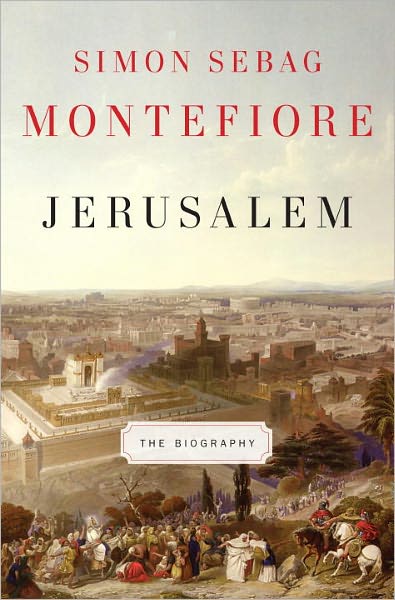
You’ve met that guy at a party who impresses you with his authoritative confidence about various subjects—that is, until he wanders into an area you’re keenly familiar with. It’s then that you want to interject into his pronouncements, “No, wait, it’s not quite like that.” And you begin to doubt the accuracy of his pronouncements on the other subjects you were less familiar with.
I met that guy in the pages of Simon Sebag Montefiore’s Jerusalem: The Biography.
It’s an ambitious and sweeping review of the passions and claims over Jerusalem from earliest history to the present. Montefiore often entertains, but I lost confidence that he could inform me of aspects of Jerusalem’s history I did not know since he so often got wrong aspects of the city’s history I do know.
For example, no, it is not true that “David seized the Ark of the Covenant, the emblem of God’s favour, and then abandoned Jerusalem” (p. 29). Having just completed a sermon series on David, I know the story is quite the opposite. And Muslims may be surprised at Montefiore’s claim that “Jews and Muslims believe…Abraham almost sacrificed Isaac” (p. 32) when in fact Islam teaches it was Ishmael who was spared in this story. Furthermore, there is no biblical reference to “three” magi from Persian heralding the birth of Christ (p. 53), though this is a popular and forgivable misunderstanding.
Most disappointing, though, was how badly he re-presented the story of Jesus. He says of Jesus’s capital trial, “The traditional account of the sentencing does not ring true" (p. 111).
So there you go.
For such a heavily-footnoted book, the absence of any footnote to substantiate this assertion is telling. But it’s not the only biblical account that does not ring true for Montefiore. Neither, apparently, does much in the New Testament before or after the account of the sentencing. Jesus did not believe about himself the things later followers claimed, Montefiore asserts: “He did not call himself the Messiah, emphasizing the Shema, the basic Jewish prayer to the one God” (p. 107). In fact, says Montefiore: “The Gospels were vague about Jesus’ nature and his relationship to God. Was Jesus a man with some divine characteristics or God inhabiting the body of a man?” (p. 152)
On the contrary, Jesus and the Gospel writers had very definite views on this subject. Everything Jesus did and said pointed to his claim to be the longed-for Messiah, and his commitment to the Shema has to be incorporated into the whole if you want to understand Jesus’ understanding of himself. Fully God and fully man: The creeds would later codify this view, not invent it.
Of course, it is Paul (it’s always that pesky Paul) who is to be blamed for enthusiastically transforming Jesus the common itinerant teacher into Christ the cosmic savior:
An unmarried, puritanical loner, Paul endured shipwrecks, robberies, beatings, and stonings on his travels, yet nothing distracted him from his mission—to remodel the rustic Jewish Galilean into Jesus Christ, the saviour of all mankind who would imminently return in the Second Coming—the Kingdom of Heaven. (p. 123)
Well then.
Of course, Paul’s wasn’t the only view circulating at the time. And so we are informed that “Christianity was not so much a single religion as a bundle of different traditions” including Gnostics. And presumably everyone got on harmoniously until enforced conformity to orthodoxy meant Gnostic texts “were probably hidden in the fourth century when the Christian emperors started to crack down on heresies” (p. 146).
Paging Dan Brown.
Thus, with this view that earliest Christianity was really a hodgepodge of Christianities, it’s no surprise to read Montefiore’s reassurance that, though Muslims reject the divinity of Jesus, “this seems more an attack on Trinitarianism than on Christianity as a whole” (p. 192). In fact, there is no such thing as New Testament Christianity that is not Trinitarian.
It’s as if Montefiore attended a session of the Jesus Seminar in the ‘80s and depended exclusively on that for his presentation of Christianity.*
I am less informed about Jerusalem’s history beyond the Old Testament and New Testament periods. In fact, that is why I bought the book. But with Montefiore’s mishandling of the parts of Jerusalem’s history I was well acquainted with, I spent the rest of the book always half-skeptical as to how accurate his entertaining stories were.
I certainly found some of the stories sad and tragic: violent crusades, gullible pilgrims, brawling priests, persecuted Jews, and unholy hucksterism at holy sites. And yet, each time I would begin to get emotionally engaged in these accounts, I would recall his mishandling of stories I was familiar with, and I would draw back in doubt as to how accurate Montefiore’s reporting really was.
Out of five stars, I give the book two: one for how entertaining it is, one for how ambitious it is. Let’s leave it at that.
____________________
*If you’re wanting more information on the reliability of the New Testament for accurate information about what Jesus really taught about himself—and the unreliability of Gnostic alternatives—you should read N.T. Wright, Larry Hurtado, Darryl Bock, Richard Bauckham, or start with the popular-level book, The Case for the Real Jesus, by Lee Strobel.
No comments:
Post a Comment